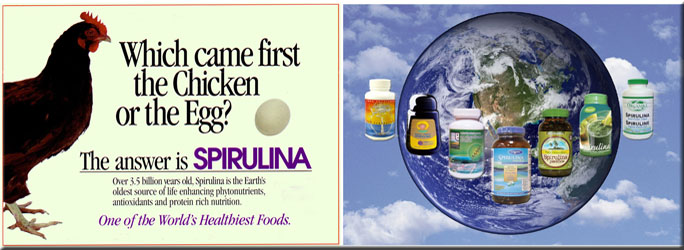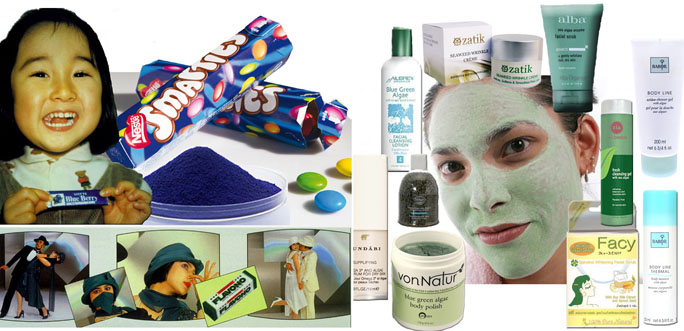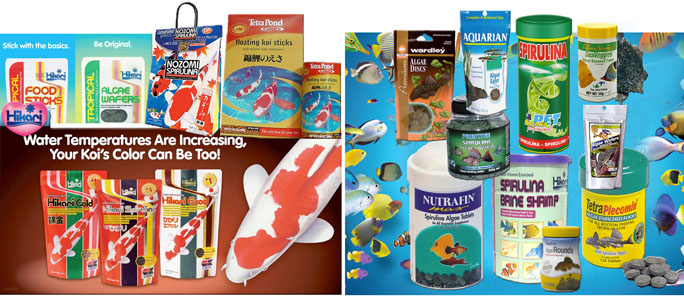6. Products and Markets
Spirulina products around the world
In over 40 countries, tablets, powder and capsules are widely used supplements. Spirulina is a featured ingredient in pasta, cookies, snack bars and juice drinks, and in personal care products like skin creams and shampoos. Look for it in innovative pet supplements for fish, aquatic animals, birds, cats and dogs. Natural food colors from spirulina have been used in Japan for years.
Marketing spirulina products around the world in over 40 countries.
Market evolution in the USA
In the USA, spirulina was introduced in 1979 through natural food stores by Earthrise Company and through network marketing. Natural food customers embraced algae, discovering many ways to use it. Spirulina gathered a small, dedicated and steadily growing following, but remained a long way from mainstream recognition.
In 1981, National Enquirer front page headlines announced: Doctor’s Praise: A Safe Diet Pill – You’ll Never Go Hungry. The article claimed spirulina was a safe appetite suppressant. It became an overnight diet phenomenon. Hundreds of diet pill companies jumped on the bandwagon, rushing to market. Within a month, new brands appeared in health food stores, drug stores and supermarkets.
The media hype led a boom and bust cycle. There wasn’t enough spirulina to fill market demand. The world supply was about 500 tons per year from Mexico and Thailand. Much of this was sold in Japan, and only several hundred tons per year of real spirulina entered the US market. Many brands sold by diet pill companies were adulterated with alfalfa or cheap green fillers. Much of the public turned away, believing spirulina was little more than a diet fad. Concerned about claims and quality, the FDA took action against algae marketing companies. The spirulina market subsided by the mid 1980s.
Natural food consumers who knew benefits of algae remained faithful. As more people recognized the real health value, demand steadily rose again, along with other green superfoods such as chlorella, aphanizomenon blue-green algae, barley grass and wheat grass. Green superfoods grew in popularity about 30% per year in the 1990s.
Presenting spirulina to the US natural food market, showing an evolution of Earthrise ads and products over two decades: 1981, 1990, 1997.
New spirulina products appeared, formulated with natural herbs, phytonutrients, vitamins and minerals to raise energy levels, boost athletic performance and endurance, promote a lighter appetite and offer antioxidant protection. Meal replacements with spirulina offered chocolate, fruit and vanilla flavors. Companies invented snack bars, pasta, and fruit and vegetable juices.
People became aware that nutraceutical foods have health benefits beyond nutrition, and whole foods with phytonutrients can help prevent disease. As more research on spirulina’s health benefits were published, it became even better known. With new dietary supplement label regulations in the 1990s, spirulina products began to display label claims about health, structure and function benefits. This new labeling and health publicity propelled food and herbal supplements into more mainstream markets.
Over this last decade, more spirulina produced in China and India reduced prices across Asia, Europe and North America. Today there may be 1000 tons or more sold in the USA market. Health and dietary supplements may represent about 80%, and 20% as an ingredient in human foods, animal and pet foods, and for extracts. Today, spirulina and other algae are ingredients in thousands of products for food, feed, colors, nutraceuticals, medicinals, cosmetics and personal care, biofertilizers and fine chemicals. Even more innovative algae based products are coming.
Spirulina is an ingredient for nutrition, color or functional effect in many international products: crackers, noodles, pasta, cereal, supplements, nutrition drinks and bars.
USA regulatory status and issues
Food: American grown spirulina produced by Earthrise and Cyanotech has GRAS Status (Generally Recognized as Safe), based on review of the published information on the safety of spirulina and on a description of their GMP and Quality Assurance Program and US Food and Drug Administration (FDA) review. Spirulina is regulated as a food and dietary supplement. In 1994, the U.S. Congress passed the Dietary Supplement Health and Education Act (DSHEA). Dietary supplements, like spirulina, are allowed to make health statements about the structure and function of the body on product labels based on scientific evidence.
Feed: As an animal feed supplement, spirulina does not yet have an AAFCO (Association of American Feed Control Officials) ingredient description, meaning it should be used in feed applications which are low priority enforcement. Since spirulina is already GRAS, AAFCO status should be achievable.
Food Colors and Additives: The US FDA regulates food colors and additives and requires a long and expensive approval process before natural colors can be used in foods and cosmetics, making it difficult for natural colors to replace chemical food dyes. However in 2013, spirulina’s phycocyanin extract was finally approved as a blue food color in the U.S.
Natural colors for foods and cosmetics
Spirulina contains 10-20% phycocyanin making it the best natural blue color for foods. Blue, red and yellow are the three primary colors, and blue is used to make other colors. In Japan, food regulations mandate the use, of natural food colors without chemicals or preservatives. Dainippon Ink & Chemicals developed a food color from spirulina called Lina-Blue®, used in chewing gum, ice cream, popsicles, candies, soft drinks, dairy products and wasabi, the green colored hot paste served in sushi bars. Another form is made for natural cosmetics.
Spirulina blue pigment phycocyanin is a food color for gums and candies. Algae is an ingredient in many personal and body care products.
A specialty food for fish, birds, animals and pets
Demand is surging for specialty aquaculture feeds that increase growth rates and disease resistance for farmed fish and prawns. Tropical fish, ornamental birds, animals and pets of all kinds consume a portion global spirulina production.
Fancy koi carp. Highly prized fish with distinctive bright red, yellow, orange, white and black markings are often seen in ornamental pools and fountains. Many koi feeds have 5 to 20% spirulina for its rich carotene pigments that enhance red and yellow patterns, while leaving a brilliant pure white. This clarity and color definition increases their value.
Popular fish foods for koi and colorfish and many aquarium foods contain spirulina. 
Popular for aquaculture grown products. The fish farming industry is growing each year. Adding spirulina to fish feeds helps solve the two biggest problems. First, farmed fish are susceptible to infection and disease. Second, the flavor, texture and skin color may be inferior to wild fish. Fish farmers have discovered five key benefits to using spirulina to improve cost/performance of fish feeds: 1) better growth rates, 2) improved quality and coloration, 3) better survival rates, 4) reduced medication requirements, 5) and reduced waste in the effluent.
Improves survival of fish fry and brine shrimp. Aqaculture fish are grown from tiny hatchery fry. Often, survival rates are very low. Spirulina added to the feed ration at 1 to 10% levels increases survival rates, allowing fish to reach market size sooner. It is the best food for tiny brine shrimp, sold in pet stores as a popular food for aquarium fish.
Health food for aquariums. For many species of exotic tropical fish, algae are an essential part of the diet. Spirulina promises five benefits for healthy aquarium fish: 1) great profile of natural vitamins and minerals, 2) rich in muco-proteins for healthy skin, 3) phycocyanin for reduced obesity and better health, 4) essential fatty acids for proper organ development, 5) rich in natural coloring agents such as carotenoids. Feeding will result in beautiful, healthy and longer-lived fish.
Health, beauty and color for ornamental birds. Zoos feed flamingos and ibis a diet rich in spirulina, and report improvement in health and color. Algae increases feather color and shine, healthy beaks and skin, and promotes good bacteria in the digestive tract. Pet birds can be more beautiful, healthier and live longer.
Enhanced fertility for bird breeders. Canary, finch, parrot, lovebird and other breeders use spirulina to increase coloration, accelerate growth, sexual maturity and improve fertility rates. Ostrich and turkey breeders use it to increase fertility and reproduction rates. It enhances desirable yellow skin coloration in chickens and increases the deep yellow color of egg yolks. Studies with chickens suggest that adding a small percentage in the diet stimulates macrophage production, improving immune performance and disease resistance without side effects.
Healthy food for cats and dogs. For healthy skin and lustrous coat, spirulina is good for cats and dogs, for nursing mothers, bottlefed kittens and puppies. Appetites of finicky cats perk up with a little sprinkled on their food. Owners report spirulina fed pets have a fresher breath odor.
Tonic for horses, cows and breeding bulls. Owners of highly valued racehorses use spirulina in their feed ration for faster times and recovery, but trainers tend to keep results secret. Dairy farmers use it to keep cows healthy by improving intestinal flora that is so important in ruminants. Reports have circulated that it increases the sperm count of breeding bulls and fertility in females.
Future expansion of spirulina products
As with other algae, spirulina will be specially grown and adapted to deliver a higher content of desired phytonutrients such as valuable pigments, polysaccharides and lipids for high value nutraceutical and pharmaceutical products. These classes of products will face higher regulatory hurdles than selling algae as a food or food supplement.
The most significant product and market expansion will come as algae production costs fall significantly this decade. Companies seeking to drive down costs in search of commercial biofuel from algae will develop new systems and technologies, introducing lower cost algae products for the food, feed and specialty product markets.
Why Spirulina? | 1. Original Lifeform | 2. Human Rediscovery | 3. Superfood Nutrition
4. Health Benefits | 5. Cultivation Worldwide | 6. Products and Markets | 7. Future of Spirulina



 SPIRULINA
SPIRULINA